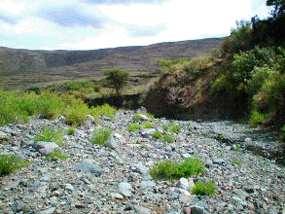Fluvial erosion
River bed of Adirako showing severe bank erosion in alluvial and colluvial infills; watershed of Adirako Dam in Ethiopia
Image Credit: Schütt, B. and Thiemann, St. 2001
Erosion starts when the flow energy of the water exceeds the resistance of the material of the river bed and banks. Flow energy depends on depth of water and gradient and thus of stream velocity. The point in time when material is set in motion is regarded as critical state. The corresponding stress is termed ‘critical shear stress’ [11]. This varies for different particles. Hjulström already recognised 1935 the relation between flow velocity and particle size of the eroded, i.e. the moved material.
Fluvial erosion proceeds in two ways:
The eroded material is transported by the river.

